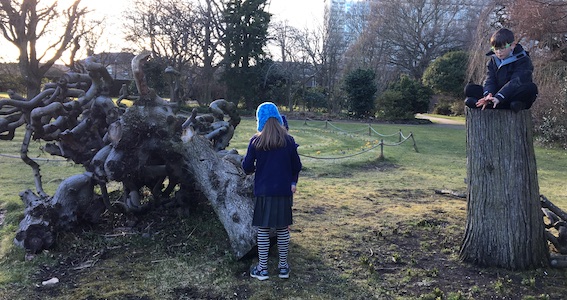
Many years ago, I was visiting Meethill School in Peterhead to do some twilight training. One of my favourite features were the stumps in the photo below. This blog post provides some thinking about why stumps are such valuable play resources.

1. A miniature fantasy world
Stumps are the ultimate fantasy miniature world place.They contain detail at a micro level which allows anyone’s imagination to run riot. One of the best things about woodlands are the old tree stumps. These make super spots and places for mixing potions. Soups of all descriptions are made in stumps by children across the world.I’m not sure whether it’s a blanket rule, but in Sweden I was told that conifer stumps with holes are spruce trees that decay from the inside out. Pointed stumps are pine trees and these decay from the outside in! Clarification about this is welcomed.
If you manage to acquire a stump, then think about its situation. If you look closely in the photo below, the stump has been raised off the ground, carefully secured and pebbles placed underneath. This creates a miniature underworld or cave.

At Cruickshank Botanic Garden, many years ago an apprentice needed to practice his chainsaw skills. So he used the stumps created after felling some trees to create wee mushroomy type of sculptures.
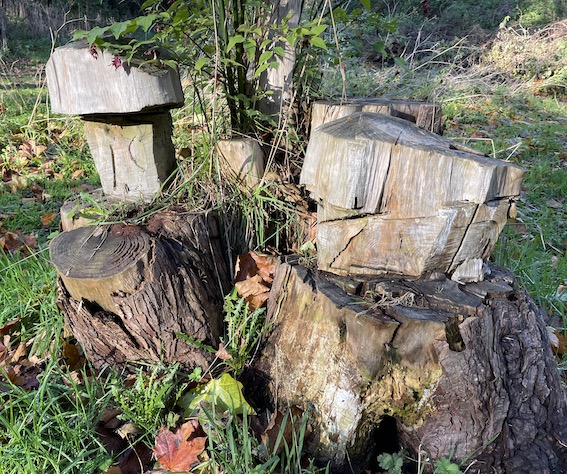
2. A place for plants to grow
In the photo below, the stumps have been planted with flowers which add to the potential play value.
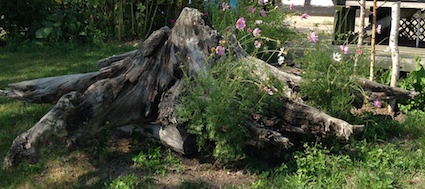
A single stump hole can also be a natural planter. It doesn’t have to be a complex stump with lots of protruding roots, a simple stump hole can suffice for being used as a planter
3. A home for other species
If you are very lucky, somewhere in your local area there maybe an upright stump. I found the beauty below in Nida in Lithuania. You may notice when out and about that sometimes trees are not cut down to the lowest possible place but part of the trunk is left. This provides living space for many different mini beasts, algae and fungi. In turn this provides food for visiting birds. Upright dead wood is dead good!
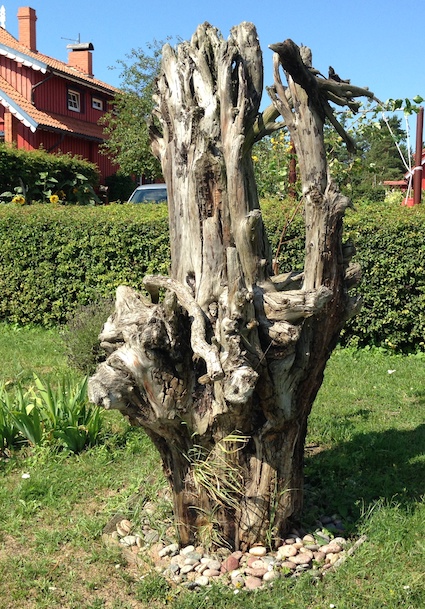
4. To help naturalise an artificial environment
At Martin Mere, the Wildfowl and Wetlands Trust Centre, there were a range of stumps in a lot of the pens. Presumably, the wildfowl and birds find them useful too – probably as a source of insects who might live there. They also help naturalise these artificially-created environments.

5. As a decorative wildlife feature
The stumps were also used as decorative features outwith the pens, such as this raised bed. However, given the height of this feature, I’m sure that more than a few children have stopped to investigate 🙂 Again, a natural mini beast home that is more likely to house little creatures than an artificial set up. It’s also often an ideal introduction to the processes of woodland decomposition. Because moss, lichen and other plants and fungi grow on stumps, children often use this time during their play to discover and learn about these organisms.
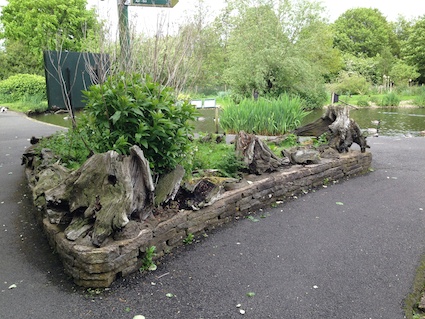
6. To experiment with solutions to issues
One major concern has been the spread of Dutch elm disease through the British Isles. A few years ago, it finally hit Cruickshank Botanic Garden and the two beautiful Camperdown Elm trees (Ulmus glabra ‘Camperdownii’) had to be cut. The one in the picture was left at this height and the new sprouts are being monitored to see whether the tree can work in a pollard-manner with the shoots being cut back only if and when the presence of the bark beetle is detected. .
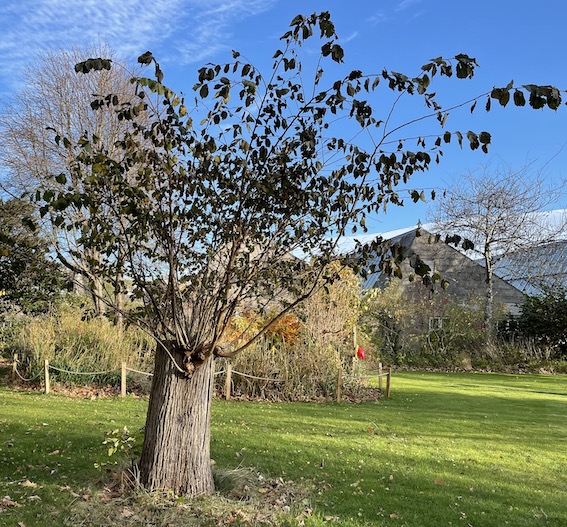
6. A natural sculpture and art work.
In Lossiemouth there is an upside down stump. It looks like a recent addition to the space outside this artist’s house. It must have a substantial trunk below the ground to remain stable and perhaps it’s even been sunk into concrete. I wonder if it will be decorated in any way…
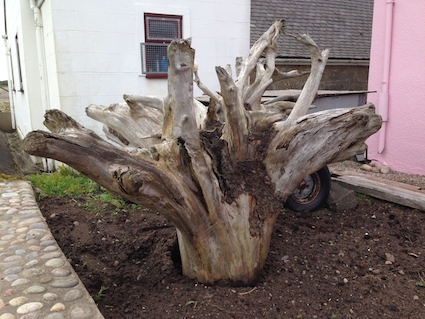
7. A place to rest
Stumps can provide lovely seats. You can create a wee seat as shown in the photo below but I’m not entirely sure how comfortable it would be.
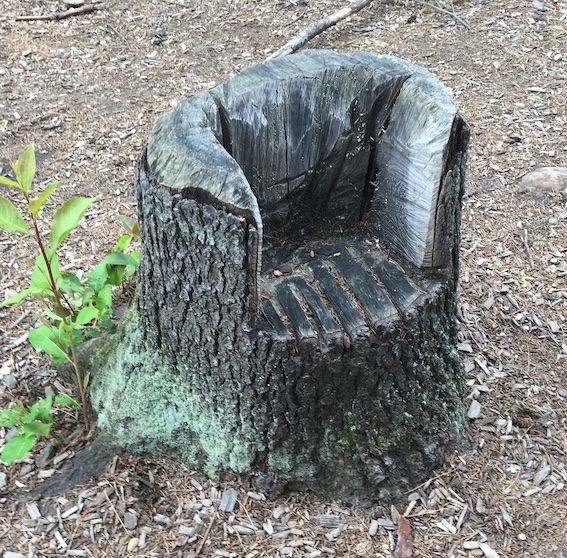
At Dundee Botanic Garden, there is a super set of stumps which I love because the layout is random. So it invites play and not simply a place to rest or to undertake formal activities.
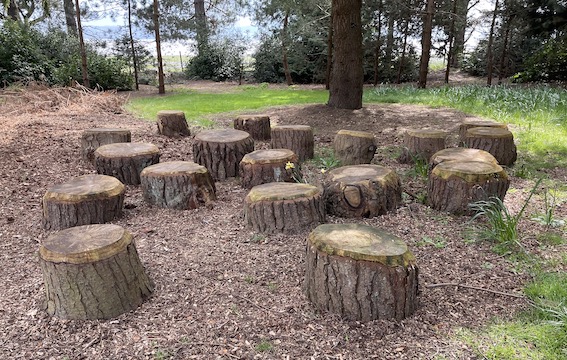
8. A place to hide things
This lovely wee stump in a forest has a hidden surprise. On closer inspection there is a tin inside! What a lovely example of clever use of enclosures to create a little bit of storage surprise and discovery…
And inside the tin is the chalk! How very practical! I would like this little storage system for my chalk too. Stump holes really are ideal storage facilities that come ready made by nature. A perfect pocket for some stones…
It adds to the awe and wonder of a play space for a little child to stumble across or find useful items inside the stump holes… such as bits of bark , leaves or twigs
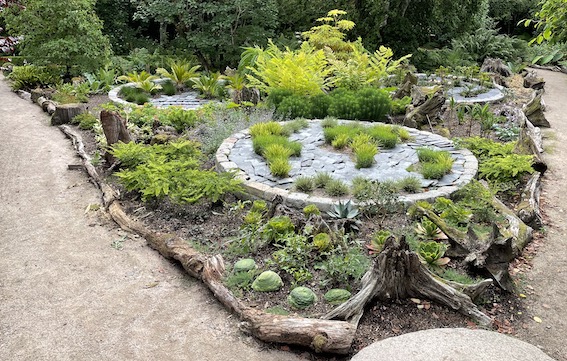
9. To continue a Victorian stumpery tradition
In the above photo, the stumps have been used to create decorative features, typical of a stumpery. In Victorian times it was fashionable to use stumps in gardening displays. The stumpery above can be seen at NTS Crathes Castle. On closer look it has all sorts of beautiful detail such as little bonsai trees growing in some of the stumps. I also love the use of branches to line the path.
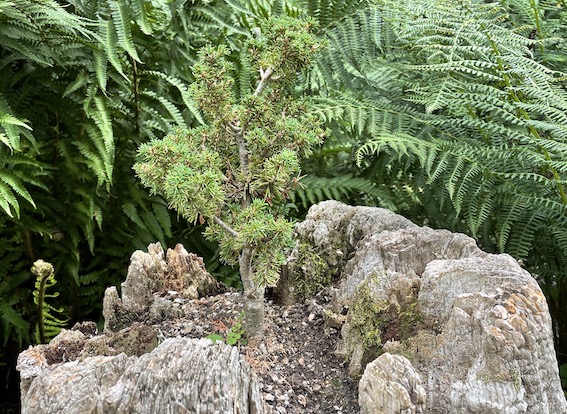
10. A place for problem solving and wondering
Flat stumps which have not developed a hole also have many uses in an educational or play environment:
- It’s an obvious opportunity to count the tree rings and look at the growth rates in different years. It also possible to see whether the tree lived in an exposed position with a prevailing wind and determine other environmental factors which affect the layout and size of the rings.
- Children, young and old, enjoy sitting on stumps, or standing on them, or jumping off them, or stepping from stump-to-stump in a ring. They can be used as a writing table too.
- Finally I like stumps for the challenge of finding out how many children or young people can fit on a stump… great fun for a group game.
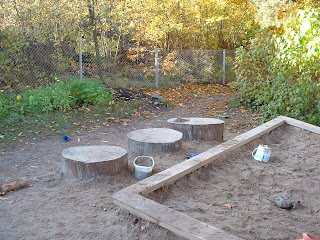
11. Exploring the joy of horizontal stumps
These lend themselves to a range of explorations including:
- A tiny miniature world play space
- A stump to crawl through or sit on top – if it’s large enough
- Checking for wildlife that may be sheltering there.
12. Sourcing stumps
Some aboricultural services and tree surgeons will occasionally donate for free. It’s worth asking around. Remember when sourcing stumps to take advice about
- appropriate sizes – both vertical and diameter of stump
- tree species – some species such as oak or beech are considerably heavier that others like pine. Also the colour and grain of wood is affected as is the rate of decomposition
- the amount of finish, such as rounding the edges – whether this is necessary in your context or not. Many schools and ELC settings prefer to file and sand down the edges for a smoother finish.
- distance from buildings for minimising fire risks, and so on. The examples in this post are all about stumps that stay in one place. As a result, you may have to site them a minimum distance from a building or outhouse for insurance purposes.
This blog post was originally published in September 2014. It is post that was an amalgamation of several others. If you like stumps, then you might enjoy this blog post about Wood logs and stumps in schools.






























These are so cool, I’m eagerly awaiting a big old oak stump for Bear Woods! I just have to organise lots do dad’s to help get it into place.
Ooh – I can’t wait to see a photo when it’s all done and in. Exciting times.
a great wildlife idea, nice to give a home to bugs and beasties. Here we tend to see cut trees made into benches and animals. over from #countrykids
Thanks Elaine – good point about the stumps being home for wildlife too.
These are great – must look out for some now! #countrykids